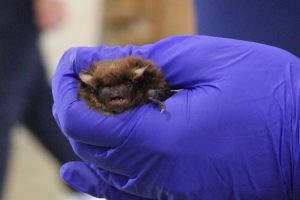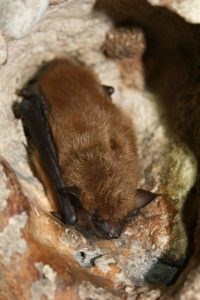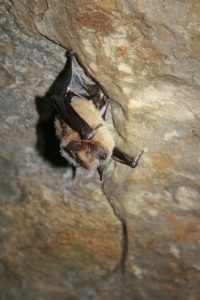This content was originally published by the Longmont Observer and is licensed under a Creative Commons license.
The fourth installment of my Halloween series is about big brown bats. Whenever I think of bats, I am always reminded of Scooby Doo for some reason. Guess I’m dating myself! Regardless, we have these beneficial animals in Longmont, so it’s a good time to learn about their benefits and how to help them.
Big brown bats are found throughout the United States, including Colorado. They are frequently found in cities. In fact, the big brown bat is the bat most closely associated with humans of all the North American bats. It is a large bat with brown fur that ranges from rust colored to nearly black. The ears are medium sized, up to about three-quarters of an inch, and are rounded. From head to tail, the big brown bat is between four and five inches long, with an average wingspan of 12 inches. The tail accounts for less than half the overall length. Big brown bats only weigh about eight-tenths of an ounce, and females tend to be larger than the males.

Big brown bats are found in both urban and rural environments. They will roost in manmade structures as well as rock crevices, and trees. In the summertime, big brown bats gather in large groups. Temperature plays a role in where they roost, with the female preferring a higher temperature than the male. In the wintertime, big brown bats hibernate in rock crevices, mines, and caves among other locations. Bats are able to get into houses through very small openings. Once inside, they prefer to roost in double walls and boxed-in eaves.
Big brown bats are insectivorous and therefore are beneficial to humans. Studies show these bats consume insects that are harmful to humans. They eat large, flying insects and have a preference for beetles. Sometimes they will even eat beetles that are too large for them to fly away with. Big brown bats are nocturnal feeders and they have a predictable flight pattern when they emerge to feed at night. When the weather is good, they will begin foraging 20 minutes to an hour after sunset. Big brown bats don’t forage when it is raining or the temperature is below 50 degrees Fahrenheit. They generally forage in open areas that allow them to fly in figure eights. Once full, big brown bats will retire to a “night roost” where they will hang and digest their meal. They will return to their regular roost before dawn. Because big brown bats eat insects, they must hibernate in the winter when insects are not around. In order to hibernate, they need to accumulate up to 30% of their body weight in fat reserves. Big brown bats may also move during the winter to a better hibernation spot.

Bats are known to use echolocation to hunt and avoid obstacles. Echolocation provides bats with an acoustic image that is created by the echoes in relation to where the bat emitted the call. They are capable of tracking insects into vegetation without crashing into the vegetation itself. Calls are emitted through the open mouth. The time between calls and the length of the call varies depending on the activity the bat is engaged in at the time. There are different calls for searching for prey, approaching prey, attacking prey, or for when they are at the end of an attack. Bats generally increase their call rate as they get closer to their prey. An attack on prey is associated with a “feeding buzz” generated by a high repetition of calls. Bats may orient themselves to the loudest sounds they hear as this tends to be associated with a high density of insects. In addition to the inaudible sounds made by bats during hunting, they make audible squeaks and hisses at roosts and nests.
Big brown bats mate in the fall. The female will store the sperm in her uterus over the winter, and the young will be born in midsummer. Gestation lasts about two months. Typically, females give birth to a single offspring, although eastern big brown bats frequently have twins. Female bats will form maternity colonies of several hundred individuals to rear their young. Males will roost by themselves or in small groups while the young are being reared. Mothers are capable of recognizing their own offspring even though there are hundreds of young. When young fall from the nest, they emit a squeaking sound that can be heard up to 30 feet away. Studies indicate that mothers will retrieve their young and place them back in the nest.
The big brown bat is also known for its homing ability. They have been known to return to their roost sites from up to 400 miles away. Big brown bats can travel up to 40 miles in a single night.

Bats are very beneficial to humans and the ecosystem. Not only do they eat harmful insects that might spread disease to humans or harm their crops, they also play a role in seed dissemination and plant pollination. In addition, they act as a food source for snakes, hawks, owls, and raccoons. To encourage bats to roost near you and help the ecosystem, you can erect bat boxes. These boxes give females a place to raise their young. The Organization for Bat Conservation has a FAQ for those that are interested in erecting a bat house. In order to keep bats from getting into your house, block any holes that might be used as entrances. Block the holes at night after the bats have left to feed for the night. It is also not advisable to block entrances during June or July when there might be flightless young in a roost.
Take some time during the early evening after sunset to watch for the big brown bat. They are amazing to watch as they hunt for insects. I’ll leave you with some trivia. A group of bats is known as a colony or a cloud. Until next time!


